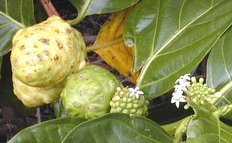Noni
|
|
| Great morinda, Noni | ||||||||||||||
|---|---|---|---|---|---|---|---|---|---|---|---|---|---|---|
| Missing image P_Morc_D1252.JPG Morinda citrifolia Leaves, flowers, and fruit of Morinda citrifolia | ||||||||||||||
| Scientific classification | ||||||||||||||
| ||||||||||||||
| Binomial name | ||||||||||||||
| Morinda citrifolia |
Morinda citrifolia, commonly known as Great morinda, Indian mulberry, Noni (from Hawaiian), or Aal (in Hindi), is a shrub or small tree in the Family Rubiaceae. Morinda citrifolia is native to Southeast Asia but has been extensively spread by man throughout India and into the Pacific islands as far as the Hawaiian Islands.
The plant grows in shady forests as well as on open rocky or sandy shores. It is tolerant of saline soils, drought conditions, and secondary soils. It therefore found in a wide variety of habitats: volcanic terrains, lava-strewn coasts, and clearings or limestone outcrops. The great morinda tree can grow up to 9 m tall. It has large, simple, dark green, shiny and deeply veined leaves.
The plant blooms and fruits all year round. The flowers are small and white. The fruit is a multiple fruit that has a pungent odor when ripening. It is oval and reaches 4-7 cm in size. At first green, the fruit turns yellow then almost white as it ripens. It contains many seeds. Despite its smell, the fruit is nevertheless eaten as a famine food and, in some Pacific islands, even a staple food, either raw or cooked. Southeast Asians and Australian Aborigines consume the fruit raw with salt or cook it with curry. Seeds are edible when roasted. In the United States and Canada "Noni" is marketed as a heath food item and is usually sold at high prices as a specialty item.
Uses
In China, Japan and even Hawaii, various parts of the tree (leaves, flowers, fruits, bark) serve as tonics and to contain fever, to treat eye and skin problems, gum and throat problems as well as constipation, stomach pain, or respiratory difficulties. In Malaysia, heated noni leaves applied to the chest are believed to relieve coughs, nausea or colic. In the Philippines, juice is extracted from the leaves as a treatment for arthritis.
The noni fruit is taken, in Indochina especially, for asthma, lumbago and dysentery. As for external uses, unripe fruits can be pounded, then mixed with salt and applied to cut or broken bones. In Hawaii, ripe fruits are applied to draw out pus from an infected boil. Overripe fruits give extracts that regulate menstruation or ease urinary difficulties.
The bark of the great morinda produces a brownish-purplish dye for batik making; on the Indonesian island of Java, the trees are cultivated for this purpose. In Hawaii, yellowish dye is extracted from its root in order to dye cloth. In Surinam and different other countries, the tree serves as a wind-break, as support for vines and as shade trees for coffee bushes. The fruit is used as a shampoo in Malaysia, where it is said to be helpful against head lice. Nonis can be fed to pig livestock.
Miscellaneous
The noni fruit is especially attractive to weaver ants, which make nests out of the leaves of the tree. These ants protect the plant from other insect predators.
External links
Phytochemicals in noni (http://www.phytochemicals.info/plants/noni.php)de:Nonija:ノニ

